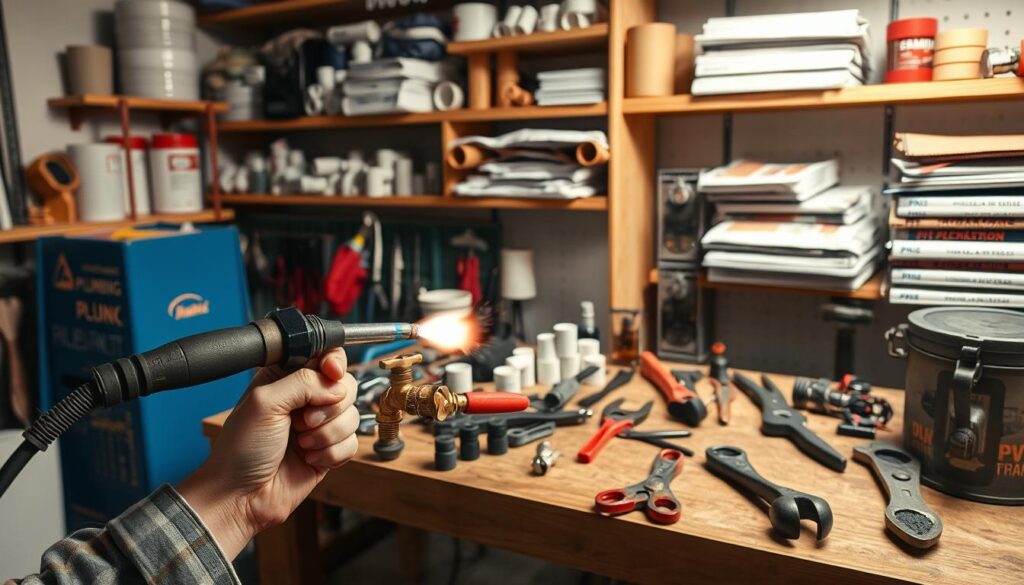Homeowners often face common plumbing issues that can be resolved through simple DIY repairs, saving them money and the hassle of calling a professional. Leaky faucets, clogged drains, and toilet issues are just a few examples of problems that can be fixed with basic tools and skills.
By taking on these simple repairs, homeowners can avoid costly service calls and gain a sense of accomplishment. For more complex issues or for those who are not comfortable with DIY repairs, it’s always best to consult plumbing experts who can provide trusted repairs and maintenance services.
Key Takeaways
- Simple DIY repairs can save homeowners money on plumbing services.
- Common issues like leaky faucets and clogged drains can be fixed with basic tools.
- Toilet repairs and replacements are crucial for reliable functionality.
- Regular maintenance can help extend the life of a plumbing system.
- Knowing when to call a professional is important for complex issues.
Understanding Common Plumbing Issues
Plumbing issues are a common occurrence in many households, but early detection and repair can prevent major problems. Dealing with anything plumbing-related can sound intimidating, but there are minor repairs that homeowners can easily do themselves.
Why Fixing Plumbing Problems Early is Crucial
Addressing plumbing issues promptly is vital to avoid more significant problems down the line. For instance, a small leak can lead to water damage, mold growth, and increased water bills if not fixed early. According to common plumbing issues, early detection can save homeowners from costly repairs.
Some key reasons to fix plumbing problems early include:
- Preventing water damage
- Reducing the risk of mold growth
- Saving on water bills
- Avoiding costly repairs
| Plumbing Issue | Potential Consequences | Benefits of Early Fix |
|---|---|---|
| Leaky Faucet | Water damage, increased bills | Saves water, reduces bills |
| Clogged Drain | Backflow, health hazards | Prevents health risks, reduces damage |
| Running Toilet | Wastewater, higher bills | Conserves water, lowers bills |
When to Call a Plumber vs. DIY
While many minor plumbing issues can be resolved with DIY solutions, there are times when it’s best to call a professional plumber. For complex issues or when you’re unsure of the problem, seeking professional help is advisable. Resources like top plumbing tools and pipes for DIY can guide homeowners in deciding when to DIY.
Some scenarios where calling a plumber is recommended include:
- Major leaks or bursts
- Complex pipe installations
- Unidentified source of the issue
By understanding common plumbing issues and knowing when to DIY or call a professional, homeowners can save time, money, and stress. Implementing simple plumbing solutions and following quick plumbing tips can make a significant difference in maintaining a healthy and functional plumbing system.
Tools Every DIY Plumber Should Have
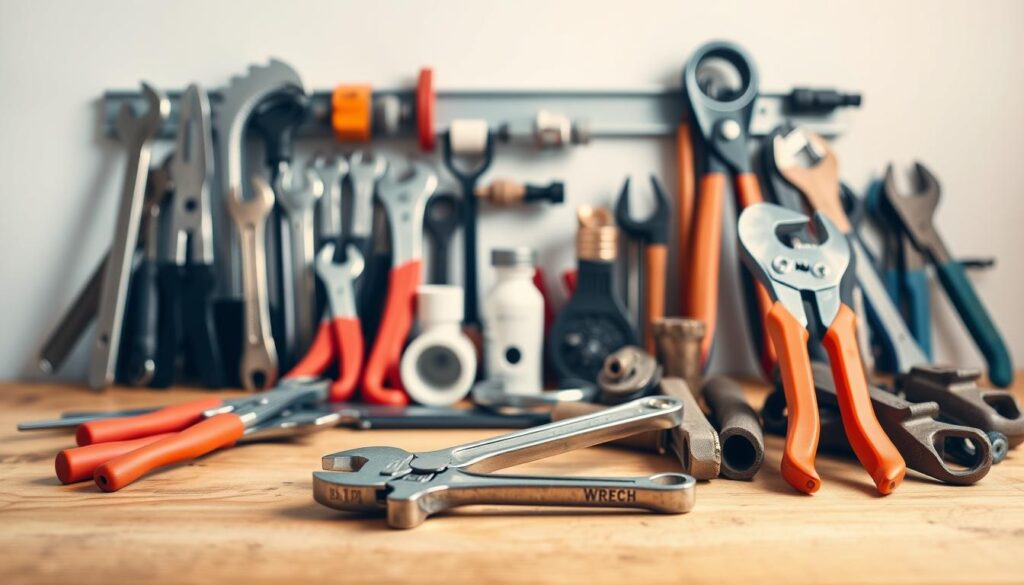
For those new to DIY plumbing, understanding the necessary tools is the first step towards successful home plumbing hacks. Having the right equipment not only makes the job easier but also ensures that repairs are done efficiently and effectively.
Essential Hand Tools for Quick Fixes
Every DIY plumber should have a set of basic hand tools to tackle common plumbing issues. Some of the essentials include:
- Adjustable wrench: Useful for gripping and twisting objects like pipe fittings.
- Thread sealant tape: Essential for creating watertight seals on threaded pipe connections.
- Pipe cutters: Necessary for cutting pipes to the right size.
- Plunger: A must-have for unclogging drains and toilets.
For more information on the tools needed for DIY plumbing, you can visit Plumbing Supply, which offers a comprehensive list of tools and equipment.
Recommended Power Tools for Home Repairs
While hand tools are sufficient for many plumbing tasks, power tools can be invaluable for more complex projects. Some recommended power tools include:
- Pipe auger: Useful for clearing clogs in drains and pipes.
- Power drill: Essential for making holes in walls or pipes.
- Reciprocating saw: Handy for cutting pipes or other materials.
These power tools can significantly simplify beginner plumbing projects, making it easier to achieve professional-looking results.
Repairing a Leaky Faucet
Don’t let a leaky faucet drive you crazy; it’s a fixable problem with a few simple steps. A leaky faucet can waste a significant amount of water, not to mention increase your utility bills. Fortunately, with some basic DIY skills and the right tools, you can fix the issue yourself.
Identifying the Source of the Leak
The first step in repairing a leaky faucet is to identify the source of the leak. Typically, leaks occur due to worn-out or damaged washers, O-rings, or valve seats. To diagnose the issue, turn on the faucet and observe where the water is coming from. If the leak is coming from the handle or spout, it’s likely related to the washer or O-ring.
For a more detailed guide on diagnosing and fixing leaky faucets, you can visit Home Depot’s plumbing repair section for additional resources and tips.
Step-by-Step Guide to Replacing Washers
Replacing a worn-out washer is a straightforward process that requires a few basic tools. Here’s a step-by-step guide:
- Turn off the water supply to the faucet by locating the shut-off valves under the sink and turning them clockwise.
- Disassemble the faucet handle to access the washer. This may involve removing a screw or clip.
- Remove the old washer and replace it with a new one that matches the original in size and material.
- Reassemble the faucet handle in the reverse order that you disassembled it.
- Turn on the water supply and check the faucet for leaks.
By following these steps, you can successfully repair a leaky faucet and enjoy the benefits of affordable plumbing fixes without calling a professional plumber. Learning how to fix plumbing issues at home not only saves you money but also gives you a sense of accomplishment.
Unclogging Drains Without Chemicals
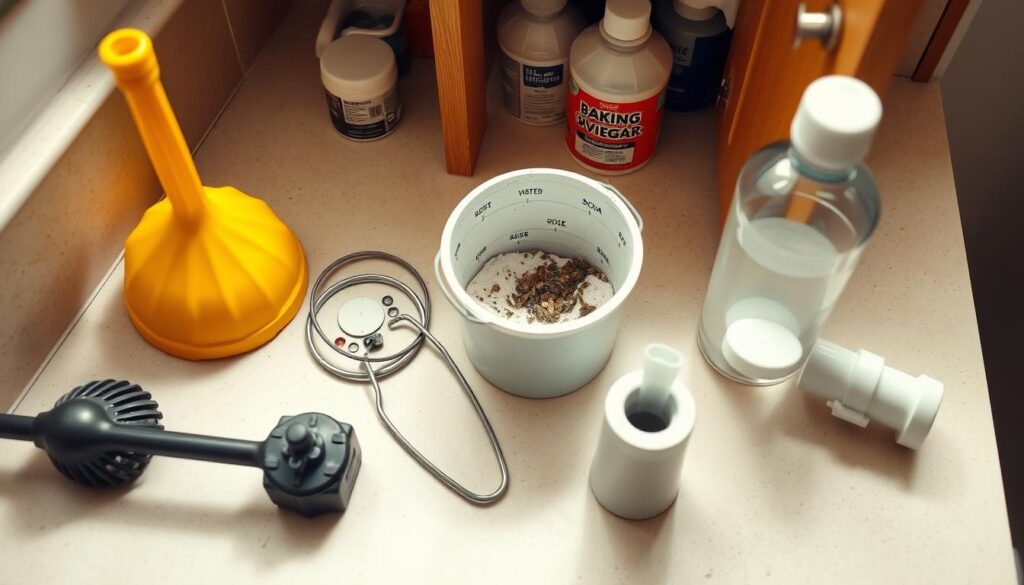
Many of us have dealt with the frustration of a clogged drain, but before reaching for chemical drain cleaners, consider safer alternatives. Clogged drains can be a nuisance, but there are effective, non-toxic methods to clear them.
Common Causes of Clogs
Understanding what causes clogs is the first step in preventing them. Common culprits include hair, grease, food particles, and soap scum. These substances can accumulate over time, narrowing the passage through which water flows, eventually leading to a blockage.
To avoid clogs, being mindful of what goes down your drains is crucial. For instance, using a drain screen can catch hair and other particles before they cause a problem.
DIY Methods for Unclogging Drains
There are several DIY methods you can try to unclog your drains without using harsh chemicals. One of the simplest and most effective tools is a plunger. It works by creating suction that can dislodge the clog.
Another method involves using a drain snake (auger). This tool allows you to reach deeper into the drain to break up or retrieve the clog.
For a more natural approach, baking soda and vinegar can be used together to create a chemical reaction that helps break down the clog. Pouring baking soda followed by vinegar down the drain, then waiting before rinsing with hot water, can be an effective solution.
| Method | Effectiveness | Environmental Impact |
|---|---|---|
| Plunger | High | Low |
| Drain Snake | High | Low |
| Baking Soda & Vinegar | Medium | Very Low |
By understanding the causes of clogs and using the right DIY methods, you can keep your drains flowing freely without exposing your pipes or the environment to harsh chemicals.
Fixing Running Toilets
If your toilet is constantly running, it’s likely due to a simple issue that can be easily fixed. A running toilet can waste a significant amount of water, leading to higher utility bills. Understanding the cause and applying a few quick plumbing tips can help resolve the issue.
Diagnosing Why Your Toilet Runs Constantly
The most common causes of a running toilet include a faulty flapper or fill valve. The flapper might not be sealing properly, or the fill valve might not be shutting off completely. To diagnose the issue, start by checking the flapper and its seal. If the flapper is damaged or not sealing correctly, consider replacing it.
Another potential cause is the water level in the tank. If the water level is too high, water will continuously flow into the overflow tube. Adjusting the float arm or the fill valve can help resolve this issue.
Simple Repairs You Can Make
For a faulty flapper, replacement is often the simplest solution. You can purchase a new flapper at most hardware stores or home improvement centers. To replace it, turn off the water supply to the toilet, drain the tank, and then remove the old flapper.
For issues related to the fill valve, you might need to adjust or replace it. Some modern fill valves are adjustable and can be fixed by tweaking the settings. For more complex problems, consider replacing the entire fill valve assembly. For detailed instructions, you can visit this resource for additional guidance.
Key Steps to Fix a Running Toilet:
- Check the flapper and its seal for damage or misalignment.
- Adjust the float arm to ensure the water level is below the overflow tube.
- Consider replacing the flapper or fill valve if adjustments don’t work.
By following these simple plumbing solutions, you can fix a running toilet and potentially save water and money on your utility bills.
Dealing with Low Water Pressure
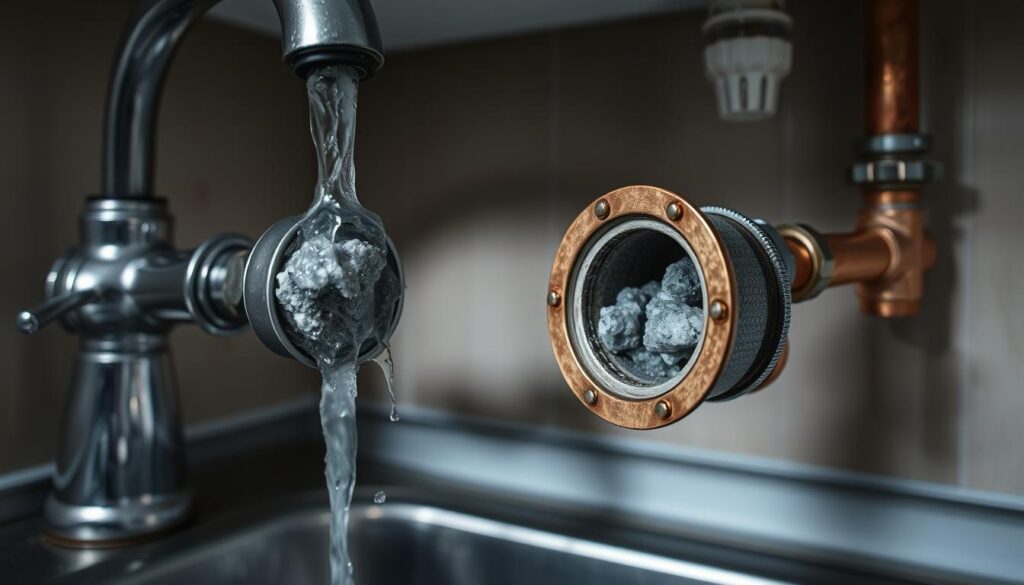
Dealing with low water pressure is a challenge many homeowners encounter, often resulting from a variety of underlying causes. Low water pressure can significantly affect the comfort and efficiency of household chores, making it essential to identify and address the root cause.
Possible Causes of Low Water Pressure
Several factors can contribute to low water pressure, including mineral buildup in pipes, issues with the municipal water supply, and problems with the home’s plumbing system. Mineral buildup, in particular, can clog aerators and showerheads, reducing water flow.
To diagnose the issue, homeowners should first check the aerators on their faucets. Cleaning or replacing these can often resolve the problem. Additionally, inspecting the water supply lines for leaks or blockages is crucial.
Quick Fixes to Improve Water Flow
One of the simplest home plumbing hacks for improving water pressure is cleaning the aerators on faucets and showerheads. Removing mineral deposits can significantly enhance water flow.
For more complex issues, such as leaks in the plumbing system, homeowners may need to employ more advanced beginner plumbing projects like inspecting and repairing pipes. Ensuring that the water supply lines are free from blockages and leaks is also vital.
By addressing these potential causes and applying these quick fixes, homeowners can often restore their water pressure to normal levels, improving the overall functionality of their plumbing system.
How to Fix a Loose Toilet Seat
Fixing a loose toilet seat is a simple DIY task that can enhance bathroom safety. A secure toilet seat is not only more comfortable to use, but it also prevents potential accidents, making it an essential part of affordable plumbing fixes that homeowners can undertake.
Tools Needed for the Repair
To fix a loose toilet seat, you’ll need a few basic tools. Typically, a screwdriver is all that’s required, although some toilet seats may have bolts that need adjusting or replacing. It’s a good idea to check your toolbox for these items before starting the repair.
- Screwdriver (flathead or Phillips, depending on the screw type)
- Adjustable wrench or basin wrench (for some toilet seat models)
- Replacement bolts or screws (if the existing ones are damaged)
Steps to Secure the Toilet Seat Properly
Securing a loose toilet seat involves tightening the screws or bolts that hold it in place. Here’s a step-by-step guide:
- Locate the screws or bolts at the back of the toilet seat.
- Use a screwdriver to tighten the screws. If they’re stripped, consider replacing them.
- For toilet seats with bolts, use an adjustable wrench to tighten them securely.
- Check the seat’s stability after tightening and adjust as necessary.
By following these steps, you can ensure your toilet seat is securely fastened, enhancing both safety and hygiene in your bathroom. This simple repair is a great example of how to fix plumbing issues at home without needing professional help.
Understanding Pipe Insulation

Insulating your pipes can significantly reduce energy loss and prevent damage. Pipe insulation is a crucial aspect of maintaining an efficient plumbing system.
Importance of Insulating Pipes
Insulating pipes is essential for several reasons. Firstly, it helps prevent pipes from freezing during cold weather, which can cause them to burst and lead to costly repairs. Secondly, it reduces heat loss from hot water pipes, making your plumbing system more energy-efficient.
Key Benefits of Pipe Insulation:
- Prevents pipe freezing
- Reduces heat loss
- Lowers energy bills
- Protects against condensation
Easy Ways to Insulate Exposed Pipes
Insulating exposed pipes is a straightforward DIY task. One of the most effective methods is using foam pipe insulation, which is readily available at most hardware stores.
To insulate your pipes:
- Measure the length and diameter of your pipes.
- Cut the foam insulation to the appropriate size.
- Wrap the insulation around the pipes, securing it with tape or glue.
By following these simple steps, you can protect your pipes and improve your home’s energy efficiency. This is one of the easy plumbing fixes anyone can do to maintain their home’s plumbing system.
For more complex plumbing issues, it’s always recommended to consult a professional to ensure that the repairs are done correctly and safely.
Repairing Small Holes in Pipes
Identifying and repairing small holes in pipes is crucial for maintaining a leak-free plumbing system. Small holes can lead to significant leaks if not addressed, causing water damage and increasing utility bills.
Types of Pipe Damage
Pipe damage can occur due to various reasons such as corrosion, freezing temperatures, or physical damage. Corrosion is a common issue in older pipes, while freezing temperatures can cause pipes to burst. It’s essential to identify the type of damage to choose the right repair method.
Simple Methods to Seal Holes
For a quick fix, pipe repair tape or epoxy putty can be used to seal small holes temporarily until a more permanent repair can be made. To apply pipe repair tape, wrap it around the damaged area, overlapping the tape as you go. For epoxy putty, mix the components and apply them to the hole, holding it in place until it sets.
These simple plumbing solutions can help you address pipe damage quickly and effectively, providing quick plumbing tips for homeowners.
How to Re-grout a Shower or Sink
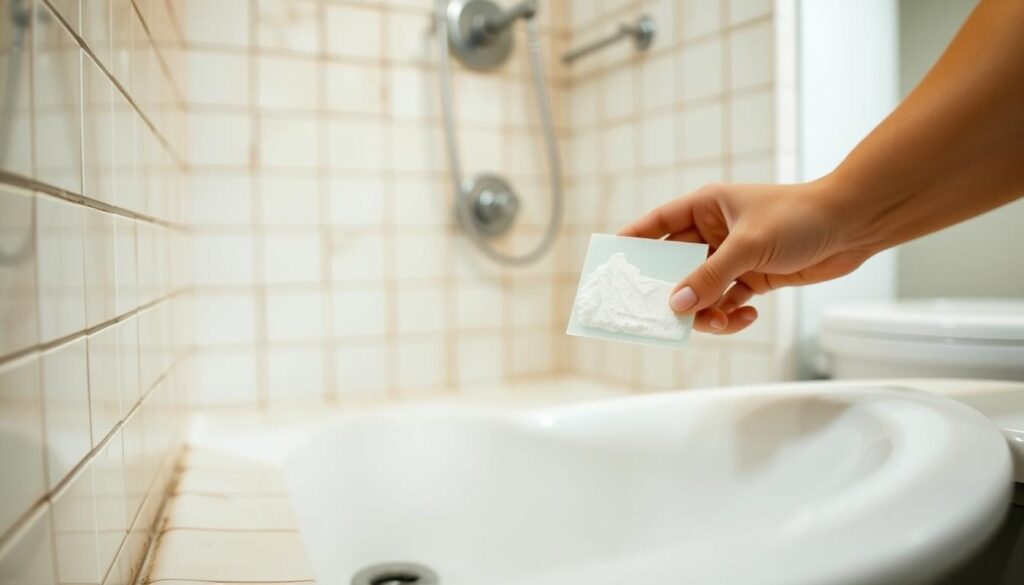
Re-grouting your shower or sink is a simple DIY project that can significantly enhance the appearance and durability of your tiles. Grout plays a vital role in tile installations, and maintaining it is crucial for preventing water damage and ensuring the longevity of your tiles.
Signs You Need to Re-grout
It’s essential to identify when your grout needs attention. Common signs include cracked or missing grout, which can lead to water seepage behind the tiles, potentially causing damage or mold growth. If you notice any of these issues, it’s time to re-grout.
Step-by-Step Grouting Process
Re-grouting involves removing the old grout and applying new grout. Here’s a step-by-step guide to help you through the process:
- Prepare the area by removing any soap scum or mildew.
- Use a grout remover to remove the old grout. For detailed instructions, you can visit Lowe’s guide on repairing tile grout.
- Clean the area thoroughly to remove any remaining grout residue.
- Apply new grout using a grout float, pressing it firmly into the gaps between the tiles.
- Wipe away excess grout with a damp sponge.
- Allow the grout to dry completely before sealing (if necessary).
By following these steps, you can successfully re-grout your shower or sink, enhancing the overall appearance and integrity of your tile work. This beginner plumbing project is a great way to improve your home’s maintenance and potentially save on future repair costs.
Installing a New Showerhead
Give your shower a refresh by installing a new showerhead, a simple task that yields great results. Upgrading your showerhead can enhance your overall shower experience, providing better water pressure and more features like massage settings.
Choosing the Right Showerhead
When selecting a new showerhead, consider factors such as water pressure, spray patterns, and eco-friendliness. Low-flow showerheads are ideal for conserving water, while showerheads with multiple spray settings can enhance your shower experience.
It’s also essential to check the compatibility of the showerhead with your existing plumbing system. Look for showerheads with easy-to-install designs that fit your shower arm.
Easy Installation Steps
Installing a new showerhead is a straightforward process. Start by turning off the water supply to avoid any leaks or water damage during the installation.
- Remove the old showerhead by unscrewing it from the shower arm.
- Clean the threads on the shower arm to ensure a secure fit for the new showerhead.
- Apply thread sealant tape to the shower arm threads to prevent leaks.
- Screw on the new showerhead until it’s snug.
- Turn on the water supply and check for leaks.
Using thread sealant tape is crucial in preventing leaks and ensuring a watertight seal. This simple step can save you from potential water damage and the hassle of dealing with leaks.
Addressing Water Heater Issues
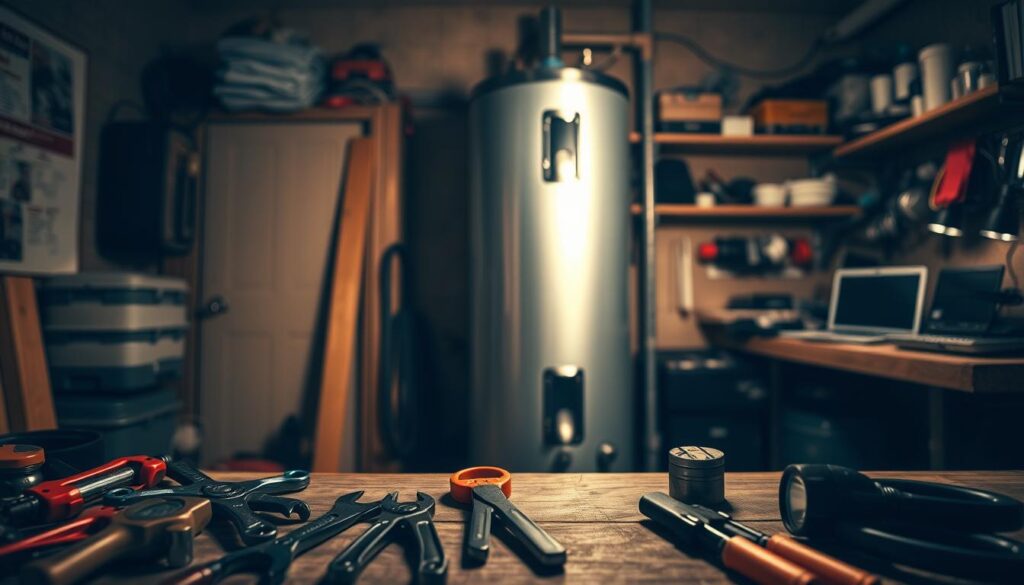
Many homeowners face water heater issues at some point, but knowing how to diagnose and fix common problems can save time and money. Water heaters are a crucial component of household plumbing, providing hot water for various needs.
Common Problems with Water Heaters
Water heaters can experience several issues, including leaks, inadequate hot water, and strange noises. Leaks often occur from the temperature and pressure relief valve or the drain valve. Understanding these common problems is the first step towards resolving them.
Some common issues include:
- Leaks from valves or the tank itself
- Inadequate hot water supply
- Noisy operation
For instance, a leak from the temperature and pressure relief valve can indicate excessive pressure within the tank. Checking the valve and ensuring it’s functioning correctly can often resolve this issue.
| Issue | Possible Cause | DIY Fix |
|---|---|---|
| Leaking | Faulty temperature and pressure relief valve | Replace the valve |
| Insufficient hot water | Incorrect temperature setting | Adjust the temperature setting |
| Noisy operation | Sediment buildup | Flush the tank |
Maintenance Tips for Longevity
Regular maintenance is key to extending the life of your water heater. Simple tasks like checking the temperature setting, inspecting for leaks, and flushing the tank can prevent many common issues.
As Energy Star suggests, setting the temperature to 120°F can help reduce energy consumption and prolong the heater’s lifespan. Additionally, annual flushing of the tank can remove sediment buildup, improving efficiency and reducing noise.
“Regular maintenance not only extends the life of your water heater but also ensures it operates efficiently, saving you money on energy bills.” –
By following these maintenance tips and understanding common water heater issues, homeowners can perform DIY plumbing repairs effectively, ensuring their water heater operates reliably for years to come.
Fixing a Stuck Valve
A stuck valve is a common plumbing issue that can often be resolved with the right techniques. Valves can become stuck due to corrosion, mineral buildup, or lack of maintenance. Understanding how to identify and fix a stuck valve can save you from more significant problems down the line.
Identifying Stuck Valves
The first step in fixing a stuck valve is identifying the issue. A stuck valve may not turn or may be difficult to turn. You might notice a leak or reduced water pressure if the valve is not fully open or closed. Inspect your valves regularly to catch any potential issues early.
How to Free Stuck Valves Safely
To free a stuck valve, you can try using penetrating oil or applying heat. Penetrating oil can help loosen corrosion, while heat can expand the metal, making it easier to turn. For more information on unsticking a plumbing valve, you can visit this resource. It’s crucial to avoid using excessive force, which could damage the valve or surrounding pipes.
| Method | Description | Caution |
|---|---|---|
| Penetrating Oil | Loosens corrosion | Avoid skin contact |
| Applying Heat | Expands metal for easier turning | Be cautious of burns |
Preventative Measures for Future Plumbing Problems
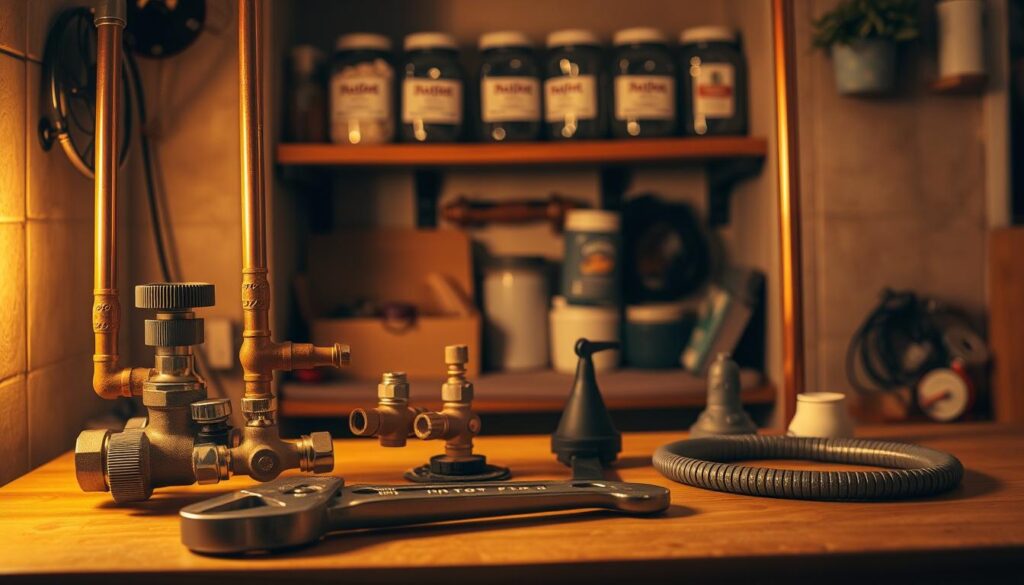
Regular upkeep is key to a trouble-free plumbing system. By adopting a few simple habits, homeowners can significantly reduce the likelihood of plumbing issues.
Regular Maintenance Tips
Regular maintenance is crucial for preventing plumbing problems. This includes checking for leaks under sinks, inspecting plumbing fixtures for signs of wear, and ensuring that water heaters are functioning properly.
- Check for leaks under sinks and around appliances.
- Inspect plumbing fixtures for signs of wear or damage.
- Test your water heater to ensure it’s working efficiently.
Importance of Seasonal Checks
Seasonal checks are also vital for maintaining a healthy plumbing system. Before winter, inspect exposed pipes for signs of damage or wear, and consider insulating them to prevent freezing.
| Season | Check | Action |
|---|---|---|
| Winter | Inspect exposed pipes | Insulate pipes to prevent freezing |
| Spring | Check for leaks | Repair any leaks found |
| Summer | Inspect outdoor faucets | Replace worn-out washers |
By following these preventative measures, homeowners can enjoy a more reliable and efficient plumbing system, reducing the need for costly repairs.
Conclusion: Empower Yourself with DIY Plumbing
Mastering basic plumbing repairs can save you money and reduce stress. By learning affordable plumbing fixes, you can tackle common issues around the house.
Key Takeaways
This article has covered various DIY plumbing solutions, including fixing leaky faucets, unclogging drains, and addressing low water pressure. These how to fix plumbing issues at home guides have equipped you with the knowledge to handle everyday plumbing problems.
Knowing Your Limits
While DIY plumbing can be cost-effective, some issues require professional attention. Recognizing when to call a plumber is crucial to prevent further damage and ensure your safety. By understanding your limits, you can confidently tackle plumbing tasks and know when to seek expert help.
